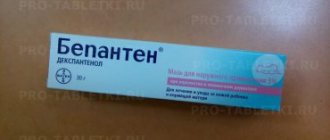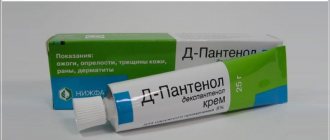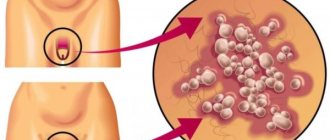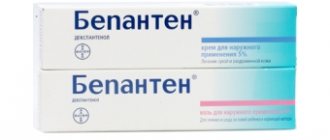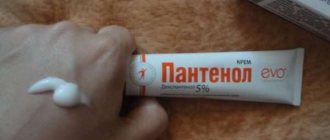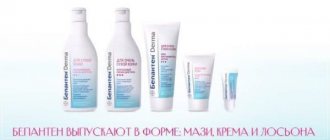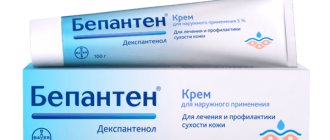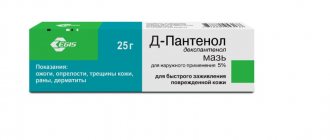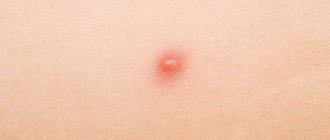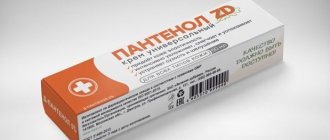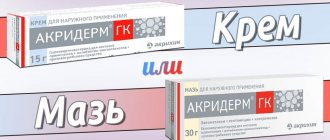Similarities between the compositions of Bepanthen and Dexpanthenol
The medications are based on vitamin B5 and are similar in composition to each other. They are used to improve tissue regeneration and intracellular metabolism. The products are used for damage to the epidermis, such as burns, wounds, and diaper rash. Dexpanthenol improves skin restoration at the cellular level. Depending on where the affected area is located, the appropriate form of the remedy is prescribed. An ointment, gel, spray, or lotion is often prescribed.
The medicine must be prescribed by a doctor. Deyspanthenol and Bepanten are stimulators of cell regeneration. The effectiveness of treatment is achieved by entering the deep layers of the skin. The cream is applied to the skin surface, it is quickly absorbed, and by combining with proteins it forms pantothenic acid.
The active substance is an acylation catalyst. Vitamin B normalizes tissue metabolism. Pantothenic acid softens the skin. The hydrophilicity of the active substance promotes penetration into the skin.
Bepanten is produced in the form of ointment, cream and lotion. Dexpanthenol is produced in the form of a gel and ointment. Bepanten is packaged in tubes of 3 g and 30 g, in plastic bottles of 200 ml. Dexpanthenol is packaged in 30 g tubes and containers with a solution for injections. The concentration of the active substance provitamin B5 in both drugs is 5%.
Dexpanthenol includes the following additional components:
- propyl parahydroxybenzoate;
- Vaseline oil;
- water;
- isopropyl myristate.
They are needed to enhance the effects of the active substance. Additional components are synthetic substances. Bepanten, produced in Germany, has only natural ingredients:
- wax;
- almond oil;
- lanolin;
- alcohol;
- paraffin.
We recommend reading: How to properly use Sodium Heparin for varicose veins?
Both products are intended for topical use. The ointment is evenly applied and distributed over the surface of the affected area. Rub the product into the skin with light movements.
Bepanten should be rubbed into the skin with light movements.
Treatment is carried out 2 to 6 times a day. The duration of treatment is prescribed by a dermatologist depending on the nature of the disease.
Indications for the use of both drugs:
- bedsores;
- wounds;
- inflammatory skin lesions;
- boils;
- acne;
- abrasions;
- burns;
- colostomy;
- skin care after surgery;
- protection of the skin when the surface layer is dry;
- diaper rash in infants;
- nipple wounds in women during breastfeeding.
Dexpanthenol is also used in cases of corneal damage, eye burns, erosive processes, and keratitis. Both drugs are well tolerated by patients. Contraindication for use is hypersensitivity to the components of the drugs. The method of application and dosage is prescribed by a dermatologist individually to each patient.
In this case, the location of the source of the disease and complications are taken into account. When treating diaper rash in infants, use 5-10 mg of Bepanten. The procedure is carried out after changing the diaper. Therapy continues until symptoms resolve.
Dexpanthenol is also used in cases of corneal damage, eye burns, erosive processes, and keratitis.
Release forms and price
Bepanten is available in two dosage forms, the concentration of the active substance in which is the same - 5%. The price depends on the volume of the tube:
- ointment, 30 g – 425 rub.; 50 g – 538 rubles;
- 100 g – 748 rub.;
- 50 g – 557 rubles;
- 100 g – 809 rubles.
Dexpanthenol is produced by domestic pharmaceutical companies only in the form of a 5% ointment, the cost of which depends on the manufacturer and volume of the drug:
- 25 g – 109-134 rubles;
- 30 g – 160 rubles.
What is the difference between Bepanten and Dexpanthenol
Both drugs contain a 5% chemical substance - dexpanthenol, which is provitamin B5. The difference between these medications is that various auxiliary components were used in their creation. Dexpanthenol includes nipazole, nipagin, isopropyl myristate, and water as additional ingredients. These are cheap synthetic compounds, so the cost of the drug is low.
Bepanten contains lanolin, almond oil, wax, water, paraffin base, proteins, alcohol - natural ingredients, so the medication is more expensive.
For large areas of skin damage, Bepanten is prescribed. The consistency of the product makes it possible to distribute it evenly over the entire surface. Dexpanthenol has a wide range of applications: for the treatment of acne, abscesses, abscesses. Bepanten is ineffective for the treatment of such skin lesions.
Price
Dexpanthenol produced in Russia costs 100-200 rubles. German-made Bepanten has a price of 250-550 rubles.
We recommend reading: Compatibility of Actovegin and Mexidol
Dexpanthenol or Bepanten – which is better?
If we are guided solely by patient reviews, then the drugs Dexpanthenol and Bepanten are complete analogues with comparable effectiveness. A superficial comparison only confirms this opinion. We are talking about almost identical pharmaceuticals, the main difference between which is the manufacturer.
After treating the problem area of the skin, the active agent (provitamin B5) is converted into pantothenic acid. This substance is close in composition to the components of the dermis, and therefore is best suited for its regeneration, moisturizing and treatment.
Properties of dexpanthenol:
- moisturizes and saturates the dermis with nutrients;
- stimulates cellular regeneration in damaged segments;
- eliminates swelling, inflammation, redness and irritation;
- promotes rapid healing of cracks, abrasions and shallow wounds.
Both drugs are indicated for burns of the skin, diaper rash, dermatitis, bites, erosions, bedsores and trophic ulcers. There is no fundamental difference in terms of pharmacological action and effectiveness between the two drugs. But differences still exist.
How are these medications different?
Having carefully studied the composition of Bepanthen and Dexpanthenol, it is easy to notice that the basis of the 2 medications is a 5% chemical compound called dexpanthenol (a derivative of vitamin B5). The main differences between the pharmaceutical products under consideration are the auxiliary ingredients, which are worth dwelling on in more detail.
Additional components of Dexpanthenol:
- nipazole;
- Vaseline oil extract;
- nipagin;
- cholesterol;
- isopropyl myristate;
- purified water base.
Auxiliary ingredients typical for Bepanten:
- lanolin, extracted from sheep fat;
- almond oil extract;
- natural beeswax;
- paraffin bases;
- alcohol-containing substances;
- protein;
- distilled water.
The first of the drugs (domestic production) is based on cheap chemicals and synthetic preservatives. Thanks to this approach, it was possible to reduce the final cost of the drug without compromising its therapeutic properties. The medicine from the German company is distinguished by its exclusively natural composition and higher price.
Selection rules
For adults, the drugs in question are identical in effectiveness. When choosing, preference is most often given to Dexpanthenol due to its affordability. For infants, small children and breastfeeding mothers, Bepanten is much safer due to the naturalness of the ingredients.
What else is important to consider when choosing a medication?
- The pharmaceutical product from a German manufacturer acts immediately after application to the surface of the problem area of the skin. Diaper rash and redness disappear after 2-3 hours. The domestic analogue manifests itself only after 24 hours.
- For large affected areas, it is preferable to use Bepanten: the liquid consistency of the medicine allows you to treat the skin evenly and easily.
- Dexpanthenol has a wide range of indications. It is used to treat acne, boils and abscesses - those ailments for which Bepanten is powerless.
- Price. A domestic medicine will cost the patient 100-200 rubles, while for a Western equivalent you will have to pay from 250 to 550 rubles.
When choosing, it is important to take into account the individual needs of the patient. When it comes to daily care for newborns (diaper rash, dermatitis) and breastfeeding mothers (treatment of cracked nipples), Bepanten is safer. For adults, it is better to opt for a domestic substitute from the VERTEX company.
Reviews from doctors about Bepanten and Dexpanthenol
Silantiev Oleg Petrovich, dermatologist
These products nourish and moisturize the skin, stimulate the restoration of the skin surface in the damaged area, eliminate swelling, and heal shallow wounds and abrasions. The drugs can be used for burns, injuries, erosions, varicose veins, and skin ulcers. Both drugs exhibit high effectiveness, which is confirmed by clinical practice.
Loginova Svetlana Arsentievna, pediatrician
Bepanten is often prescribed for the treatment of diaper rash in infants. It is safe for the skin because... contains only natural ingredients. The duration of the course of therapy and the number of treatments per day are prescribed by the attending physician. You cannot use medications yourself without a doctor’s prescription, as this can be dangerous for the child.
Characteristics of Depanthenol
Depanthenol (D-panthenol) refers to reparants used in the treatment of wounds and burns. In pharmacies, the product is sold in the form of cream, ointment and aerosol. In addition to dexpanthenol, the drug contains: petroleum jelly, lanolin, propylene glycol, cellulose, fragrances, etc. D-panthenol is used to accelerate the healing properties of the skin and eliminate irritation from anal fissures, cervical erosion, bedsores, cracked nipples.
Depanthenol (D-panthenol) refers to reparants used in the treatment of wounds and burns.
Contraindication for use is individual sensitivity to the components of the product.
Patient reviews
Raisa, 32 years old
When feeding the child, cracks appeared on the nipples. I went to the doctor. He prescribed the drug Bepanten. I treated my skin 3 times a day. After a few days the cracks disappeared. Now the skin condition is good, cracks or other defects do not appear, and I have started breastfeeding again.
Max, 18 years old
For several years I have been bothered by acne; pimples appear, then go away, but new ones immediately form. I addressed this problem to a dermatologist. He prescribed Dexpanthenol. I used the medication according to the instructions prescribed by the doctor. After completing the course of treatment, the acne went away.
What's better?
If a large area of skin damage occurs, it is recommended to use Bepanten during therapeutic measures. The consistency of this product allows for the distribution of the drug over the entire damaged surface of the body in an even layer. Dexpanthenol has a wider range of applications. It can be used to treat acne, abscesses and abscesses. Bepanten is an ineffective remedy for such purposes.
When treating an adult patient, any of the drugs can be used. Since Dexpanthenol has a lower cost, most patients choose this drug.
For infants and nursing mothers, the safety of the therapeutic measures taken becomes important, therefore, for such patients it is recommended to use Bepanten, which can quickly provide a positive therapeutic effect.
When using Bepanten, the damage disappears within 3 hours after the start of therapy. Dexpanthenol has a positive therapeutic effect after 24 hours.
Differences between D-Panthenol and Bepanten
These products for stimulating epidermal regeneration are produced by different pharmaceutical companies:
- Bepanthen® is produced by Bayer (Germany);
- D-Panthenol® is manufactured by Jadran Galenski Laboratorij (Croatia).
The drugs differ in the composition of the auxiliary components.
There are also differences in the packaging of creams and ointments by different manufacturers.
D-Panthenol® (cream, ointment) is packaged:
- in aluminum tubes (25, 30, 35 or 50 g);
- in dark glass jars (5, 10, 15, 20, 25, 30, 35 or 50 g).
But most often on sale there are packages in aluminum tubes of 25 and 50 g.
Bepanthen® cream and ointment is available only in aluminum tubes, packaged in 30, 50 or 100 g. The ointment can be packaged in small tubes of 3.5 g.
The main difference between Bepanten and D-Panthenol is the use of the safest additional components to obtain the same dosage forms (ointment, cream).
Side effects of D-Panthenol and Bepanten
These drugs have low adsorption, so prolonged or heavy application to the skin does not have a systemic effect. The preparations contain only non-toxic substances.
In exceptional cases, a hypersensitivity reaction may occur. For example, allergies may manifest in the form of dermatitis, erythema, hyperemia, itching, and exanthema. Local skin reactions (for example, contact dermatitis) can be caused by some of the excipients included in these drugs (cetyl alcohol, stearyl alcohol, lanolin). Propylene glycol can also cause skin irritation.
How to take D-Panthenol and Bepanten
Cream or ointment is applied 1-4 times a day to the area of damaged epidermis cleaned with antiseptic agents. Regenerating drugs should not be used to treat weeping wounds. When using these medications, avoid contact with the eyes.
When applied externally, dexpanthenol is quickly absorbed by the skin, because molecular weight, hydrophilicity and low polarity allow it to penetrate into all layers of the epidermis. Pantothenic acid binds to plasma proteins (beta-globulin and albumin), is not metabolized and is excreted unchanged from the body.
When treating cracked nipples, you can apply compresses using these drugs after each feeding.
To prevent diaper dermatitis, Bepanten or D-Panthenol is applied under the diaper after each bath.
To heal anal fissures and cervical erosion, the drug is applied 1-2 times a day. The duration of the course of treatment is adjusted by the doctor.
Description of drugs
Release form and composition
Ointment 5%, color – light yellow, has a characteristic odor.
The main substance is dexpanthenol, auxiliary substances are petroleum jelly, cholesterol, nipazole, nipagin, water.
Ointment 5%, color – white or light yellow, has a slight odor.
The main substance is dexpanthenol, also contains: alcohol, beeswax, almond oil, paraffin, water.
Promotes skin restoration and normalizes cell metabolism.
The drug is aimed at regeneration and improvement of metabolism in cells.
2-4 times a day, apply a thin layer to damaged areas. If necessary, you can apply more often.
1-2 times a day, apply to the affected area of skin and rub in a little.
Allergies (rare).
Hives or itching may occur.
· Skin disorders: burns, abrasions, wounds, bedsores;
· Inflammations on the skin: boils, ulcers, colostomies, etc.;
· Skin care after natural phenomena: wind, frost, dampness;
· For the care and protection of skin prone to dryness.
· Dry skin with damage;
· During lactation, caring for the mammary glands;
· Baby skin care;
· Minor injuries, initial degree burns, cracks, ulcers and irritations on the skin.
Intolerance to any components included in the composition.
Individual intolerance to substances included in Bepanthen.
Pregnancy and lactation period
If there is an inflammatory process or cracks in the nipples (be sure to consult a doctor).
Can be used for diaper rash, after negative exposure to the sun, and for scratches.
Can be used when dermatitis or diaper rash appears.
Release from pharmacy
Contraindications
Both drugs cannot be used if hypersensitivity to dexpanthenol or to any other components of the drugs is diagnosed.
There is an additional contraindication for the use of Bepanthen Plus - intolerance to chlorhexidine dihydrochloride. Due to the presence of this substance in the composition, antiseptic cream should not be applied to a perforated eardrum. Antiseptic Bepanthen Plus is not used to treat children from birth to 1 year.
Bepanten Plus is used in the treatment of superficial skin lesions if there is a risk of infection.
